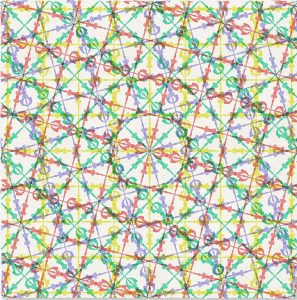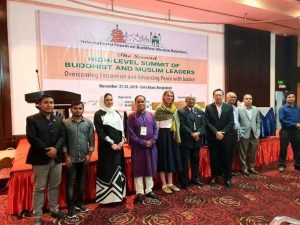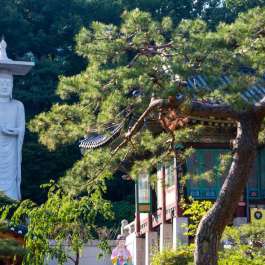
In my first two essays on the Shikoku pilgrimage, I reflected on the “dōjō” “to arouse the mind” (hosshin no dōjō) in Tokushima Prefecture* and “self-cultivation” (shugyō no dōjō) in Kōchi Prefecture.** Today, I will reflect on the dōjō of “wisdom and enlightenment” (bodai no dōjō) in Ehime Prefecture.
While the pilgrim path in Kōchi Prefecture includes fewer temples than any of the other three prefectures, it contains the longest of the four parts, about 385 kilometers. Once pilgrims leave Cape Ashizuri, the southernmost tip of Shikoku and home to temple 38, Kongōfuku-ji, they head northwest and, somewhere halfway between temples 39 and 40, eventually pass into Ehime Prefecture and, thereby, enter the dōjō of “wisdom and enlightenment.” In Ehime Prefecture, the path trails through the wild west-coast region of Shikoku, returns into the forests and hills surrounding temples 44, Daihō-ji, and 45, Iwaya-ji, descends into Matsuyama, a city of half a million people known for its hot springs (onsen), runs along the beautiful coastline in the northwest of Shikoku bordering Hiroshima Bay and the Seto Inland Sea, and enters the mountains of Saijō City harboring Yokomine-ji (temple 60), at about 750 meters the third highest temple of the Shikoku pilgrimage route. This is the environment of the dōjō of “wisdom and enlightenment.”
But what is it that we call “enlightenment?” What do we practice over those 1,200+ kilometers? What does the practice of attunement and the cognitive transformation of our mindset from tensionality to non-tensionality imply?**
I would like to evoke here Dōgen’s notion that “practice and realization are one” (shushō ittō): “Without practice, there is no realization.”*** Enlightenment is not the goal of practice but it is practice. To be exact, the “practice-realization of the self in the direction of the 10,000 dharmas.”****
The key to these questions of what enlightenment is might lie in the clothing of the pilgrims and the utensils they carry along the pilgrimage through all kind of weather, into the mountains, and along highways as well as trails. One topic that I have not talked about so far is the outfit and utensils that pilgrims are expected to wear and carry. In addition to the nōkyōsho, the booklet in which the pilgrims collect the seals of the 88 temples on their route, the rosary (nenjū), a sūtra and mantra book, the osame fuda (petitions to be left at the hondō—main hall—and the Kōbō Daishi-hall at each temple), incense and matches, pilgrims use a hiking stick, kongōtsue (diamond stick) and wear a hat (henro kasa), the waka kesa (vestments), and a robe.
The robe as well as the bag (zuda bukuro), which many pilgrims use to carry the nōkyōsho, the candles, the sūtra book, incense, and so on, are imprinted with the phrase “dōgyō ninin”—the Shingon version of the anthem sang by fans of Liverpool Football Club: “You’ll Never Walk Alone.” The phrase dōgyō ninin translates as “walking together, two people.” According to Shingon doctrine, pilgrims are never alone; Kūkai walks with us. In the light of six weeks of solitary hiking, this idea is extremely comforting. However, as a philosopher I became hung up at the seeming contradiction that pilgrims are encouraged to visit Kūkai on Mt. Kōya after having concluded the henro michi to 88 temples, ostensibly to report to Kūkai that they have finished the full pilgrimage route, yet that very Kūkai was said to walk with me. It is orthodox Shingon belief that Kūkai has not passed away but resides in the mausoleum on Mt. Kōya, the Okunoin, sitting in eternal meditation. But the idea of divine company, if not protection, is important in its message and beneficial during those long hours on the road and in the mountains.
Be that it as it may, for me, the phrase dōgyō ninin took on two additional meanings as well, a personal and political one: having recently lost the second of my parents, the rituals at each temple transformed into commemoration rituals. The ritual to be chanted at each temple is not unlike the one practitioners perform at a commemoration ritual. So, in some sense, the pilgrimage became a long way to say goodbye to my parents and the phrase “walking together, two people” meant that I was walking with them.
In another sense, the phrase “walking together, two people” echoed for me what Trinh Minh Ha referred to as “walking with the disappeared,” a pilgrimage that I have done more explicitly to, among other places, Dachau, Wounded Knee, Hiroshima, Sendai, and Nanjing—pilgrimages to and with the dispossessed, the voiceless who disappeared in the margins of history. As someone who grew up in post-war Germany and has lived in Germany, the United States, Japan, and Hong Kong, I am painfully aware of the trail of tears that we as humanity have left behind us. So when I walk seemingly alone for hours on the road to places of remembrance—temples are such places as is indicated by the seemingly omnipresent images of Jizō Bodhisattva, who is said to advocate on behalf of the dead to make them heard—I walk in the company of those who “disappeared.” Such a pilgrimage, to cite Trinh Minh Ha, “makes both talk and silence stained with shame” and returns “to just where one thinks one last knows.”****
During my pilgrimage, many people I met related to me, not as a foreigner, but as a pilgrim with whom they talked about the route, the experience, the loneliness, as well as snakes and boars. It was then that I realized, again in Trinh Minh Ha’s words: “Sometimes the mind freezes and the heart goes on fasting: name, nation, identity, citizenship disappear. Once I was a human.”***** This is at the core of pilgrimage, the rediscovery of our commonalities, our humanity, the way we humans actualize “buddha-nature,” when we are thrown back to the basics of sleeping, walking, eating, breathing, when, in the face of the divine, we remember our histories, we remember who we are and what we are, when all constructed identities and “glass curtains”***** disappear, when we remember: we are all human beings, actualizations of the Buddha.

The experience of “enlightenment” that develops through the long practice of attunement can be best summarized in the words of Trinh Minh Ha:
Sometimes in unexpected turns of small and large events, a sickness of the system may help to chart new ground, bring out what lies dormant, and open one’s sight to what’s already always flowering within. From the muck and the mud, the lotus arises clean and pure.******
* Religion as Practice: The Shikoku Pilgrimage in Japan (BDG)
** Practice of Attunement: The Shikoku Pilgrimage (BDG)
*** Ōkubo, Dōshū, ed. 1969–70. Dōgen zenji zenshū (Complete Works of Zen Master Dōgen). Two volumes. Ed. Tokyo: Chikuma Shobō. [Abbr. DZZ].
**** DZZ 1:7.
***** Trinh Minh Ha. 2016. Lovecidal – Walking with the Disappeared. New York: Fordham University Press. 1.
***** J. J. Clarke. 1993. Jung and the East: A Dialogue with the Orient. New York: Routledge. 17.
****** Trinh Minh Ha. 2016. Lovecidal – Walking with the Disappeared. New York: Fordham University Press. 221.
Related features from BDG
Reflecting on the Choice of Memorializing Loved Ones
Pilgrimage: Journey to Outer and Inner Landscapes
Pilgrimage: Hongluosi, Home to Priceless Artifacts and Heartwarming Legends
Let there Be Loss
Journey to the Buddha’s Homeland: Rediscovering Pilgrimage Sites in Nepal
Pilgrimage: Mount Jiuhua, Kshitigarbha’s Geopark
From Alena to Yushu, Part 2: Mountain Training
From Alena to Yushu, Part 1: How I Found My Way to Shugendo


















